Waterfall Vs Scrum – what is better?

Project management has evolved over time with agile methodologies to meet project requirements and the changing needs of businesses and industries. Today, there are many different methodologies to choose from for project managers, but two of the most popular are Waterfall and Scrum.
The methodology you choose can have a significant impact on the success of your project. Waterfall is a traditional methodology that follows a more linear workflow and approach. Scrum is an Agile methodology emphasising an iterative and incremental approach to software development and collaboration.
In this article, we will compare and contrast Waterfall and Scrum to help you decide which methodology agile approach is right for your project.
Waterfall vs Scrum What’s the Difference
Scrum is an Agile project management framework that emphasises iterative development and collaboration. It is an agile framework based on the idea that projects are best managed by breaking them down into smaller, more manageable tasks. Scrum teams work in short sprints, typically two weeks long, to complete these tasks.
Scrum was developed by Jeff Sutherland in 1993, inspired by Rugby formations. The Scrum framework comprises three key roles: the Scrum Master, the Product Owner, and the Development Team.
- The Scrum Master is responsible for ensuring that the Scrum framework is followed and that the team is focused on delivering working software.
- The Product Owner is responsible for the product vision and backlog, which is a prioritized list of all the features and requirements for the product.
- The Development Team is responsible for building and delivering the product.
Waterfall is a traditional project management methodology that follows a linear and sequential approach. Each project phase must be completed before moving on to the next phase of the software development process. The Waterfall methodology is often used for large and complex projects, such as software development projects.
The Waterfall methodology is based on the following phases:
- Requirements Gathering: The project team gathers and analyses requirements from the stakeholders.
- System Design: The project team designs the system architecture and components.
- Implementation: The development team builds the system according to the design specifications.
- Testing: The testing team tests the system to ensure it meets the requirements.
- Deployment: The system is deployed to the production environment.
Core Principles of Scrum and Waterfall
Scrum and Waterfall are two of the most popular project management methodologies. Each methodology has its own core principles, which are reflected in its approach to project management.
Core Principles of Scrum
- Transparency: Scrum teams are transparent with each other and with their stakeholders. This means that all information about the project is visible to everyone involved.
- Inspection: Scrum teams regularly inspect their work to identify any potential problems or areas for improvement. This helps to ensure that the project is on track and that the team is delivering value to the stakeholders.
- Adaptation: Scrum teams are adaptive to change. This means that they are willing and able to change their plans and processes as needed to meet the needs of the stakeholders.
Core Principles of Waterfall
- Fixed Dates: Waterfall projects have fixed dates for each project phase. This means that the team must work within these dates, regardless of any changes that may occur.
- Clear Requirements: Waterfall projects have clear and well-defined requirements. This helps to ensure that the project team is working towards the same goal and that the final product will meet the needs of the stakeholders.
- Defined Outcomes: Waterfall projects have defined outcomes for each project phase. This helps to track the progress of the project and to ensure that it is on track to meet its goals.
Working Mechanism and Project Management
Here’s a brief rundown of how Scrum and Waterfall differ in methodology.
Scrum Master Principles
Scrum is an iterative and incremental methodology. It uses fixed-length iterations called sprints, usually lasting up to two weeks. At the beginning of each sprint, the team selects a set of tasks to complete. The team then works on these tasks during the sprint and delivers a working product increment at the end of the sprint.
- Scrum Master: The Scrum Master is responsible for ensuring that the Scrum framework is followed and that the team is focused on delivering working software.
- Product Owner: The Product Owner is responsible for the product vision and backlog, which is a prioritised list of all the features and requirements for the product.
- Development Team: The Development Team is responsible for building and delivering the product.
Scrum teams use visual aids like the scrum board and chart to track their progress and get feedback from stakeholders. This helps to ensure that the team is on track and that the product is meeting the needs of the stakeholders.
The Waterfall Project Management Methodology:
Waterfall is a traditional project management methodology that follows a linear and sequential approach. It consists of distinct phases of project timeline: Requirements, Design, Implementation, Verification, and Maintenance.
- Requirements Gathering: The project team gathers and analyses requirements from the stakeholders.
- System Design: The project team designs the system architecture and components.
- Implementation: The software development team builds the system according to the design specifications.
- Testing: The testing team tests the system to ensure it meets the requirements.
- Deployment: The system is deployed to the production environment.
- Maintenance: The system is maintained and updated to address any bugs or new requirements.
Waterfall teams use tools like Gantt charts and document collections to map out project tasks and requirements. This helps to ensure that the project is well-planned and that all of the requirements are met.
Scrum Mastery: The Agile Approach to Project Success
In the ever-evolving landscape of project management, choosing the right methodology can be the difference between project success and failure. While Waterfall offers a linear and sequential approach, Scrum promotes iterative development and collaboration, ensuring projects adapt to changing requirements. If you’re intrigued by the Scrum framework and its potential to transform your projects, our Scrum Master Training is the perfect starting point. Dive into the world of Scrum, understand its core principles, and become a champion of agile project management.
Advantages and Disadvantages
Scrum and Waterfall are two popular project management methodologies. Each has its own advantages and disadvantages, which should be considered when choosing the right methodology for a specific project.
Scrum Advantages:
- High transparency: Scrum teams work in short sprints, which makes it easy to see progress and identify any potential problems early on.
- Collective ownership: Scrum teams are responsible for the project’s success as a whole, which fosters collaboration and a sense of ownership.
- Ability to accommodate changes: Scrum is a flexible methodology that allows for changes to be made to the project plan as needed.
- Cost savings: Scrum can help to reduce costs by avoiding rework and delays.
Scrum Disadvantages:
- Risk of scope creep: Because Scrum is so flexible, there is a risk that the scope of the project can creep over time.
- Necessity for familiarity with Scrum: Scrum teams need to be familiar with the Scrum methodology to be successful.
- Critical role of the Scrum Master: The Master plays a critical role in ensuring that the team follows the Scrum methodology and that the project is successful.
Waterfall Advantages:
- Clarity from the start: Waterfall projects have a well-defined plan from the start, which makes it clear what needs to be done and when.
- Accurate cost estimation: Waterfall projects are typically more accurate in terms of cost estimation than Scrum projects.
- Rare production delays: Waterfall projects are less likely to experience production delays than Scrum projects.
- Team flexibility: Waterfall teams are more flexible than Scrum teams in terms of the composition of the team.
Waterfall Disadvantages:
- Inflexibility to accommodate changes: Waterfall projects are not very flexible, which can make it difficult to accommodate changes once the project has started.
Ultimately, the best project management methodology for a specific project will depend on a number of factors, including the size and complexity of the project, the project manager team’s experience with different methodologies, and the level of flexibility required.
Waterfall vs Scrum – What Is Better?
Waterfall advocates that we do a significant amount of design upfront.
Scrum advocated that we should not over-design as the customers/user doesn’t know what they want. Therefore, spending time investigating would be wasted. Let’s build it, and as we develop, check with the customer to see if it’s what they want and then discuss progress.
Importantly, Scrum is not a series of mini waterfalls where we design for a few days and then build then test the next few days. We should do the design, develop and test at the same time. Removing the upfront design effort and merging it with the build. Chances are, it will take the same amount of energy to design and build, but it will be what the customer wants – better quality. We have maximised the amount of work not done by not delivering what the customer did not need.
Althris provide training in Scrum Master, Certified Product Owner, Agile and Iterative Project Management Methods.





